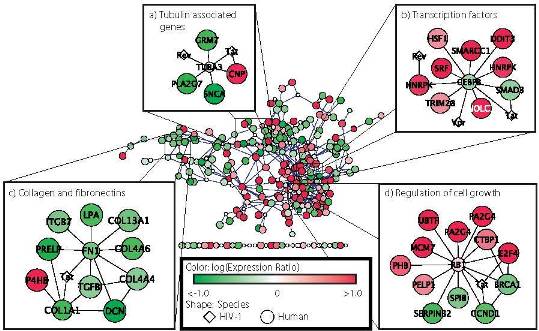IDEKER LABORATORY
University of California, San Diego
|
Lab Members' Research Projects Network-based Diagnosis and Personalized Medicine Error Analysis and Modeling of DNA microarrays |
| Application to the Study of Pathogens and Disease |
|
In collaboration with Dr. Stanley Fields and Prolexys Pharmaceuticals, we have recently applied our PathBLAST comparison tool to study the protein interaction network of Plasmodium, the pathogenic protozoan that causes malaria. Surprisingly, we found that very few regions of the Plasmodium protein network were homologous to the available protein networks of yeast, fly, worm, or bacteria [Suthram et al. Nature 2005]. This finding does not appear to be caused by noise or lack of coverage in the Plasmodium network. We are now engaged in a similar collaboration with the groups of Juergen Hass and Howard Fox to study protein networks among different herpes-like viruses and among different HIV isolates, respectively. Very early results from the HIV project appeared at the annual Pacific Symposium on Biocomputing [Bandyopadhyay et al. 2006].
Our work on modeling gene regulatory pathways is finding a different application, that of understanding the cellular response to toxicity. Together with Ben van Houten at the NIEHS, we recently published a paper identifying protein interaction circuits involved in the response of yeast to arsenic [Haugen et al. Genome Biology 2004]. Separately, we have applied systematic chromatin-immunoprecipitation and mRNA expression measurements to construct a model of the transcriptional changes brought about by exposure to methyl-methane sulfonate (MMS), a DNA alkylating agent. These efforts extend and complement several research articles the Lab contributed to, related to network models of DNA damage (papers by Begley et al.). |
